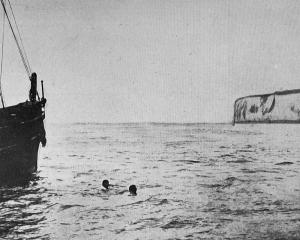In his opening remark the lecturer stated that the Australian blacks were not the lowest specimens of the human race, as was sometimes supposed.
The Tasmanian race was much lower, they had no canoes, no firesticks, no boomerang, in fact, they were in what was called the neolitic stage. They had woolly hair, but the Australians were straight-haired.
The language of the Australian blacks was very elementary, and they could not count beyond three, and had no knowledge of cultivation, but lived on what they could catch in the way of beetles, grubs, opossums, and kangaroos.
The mythological and totem beliefs were referred to, and it was explained that in most parts, in their primitive state, they had no word for God, no idea of prayer, or worship, or sacrifice, although they had elaborate ceremonies that required a great deal of preparation.
In proof of the wandering disposition engrained in the Australian blacks the lecturer mentioned that some well-to-do settlers in New South Wales who had no children adopted a black girl child and brought her up as their own.
When she had grown to be a young woman her tribe came to the neighbourhood, and the girl left her comfortable home one night and was found in the native camp wrapped in a blanket like the others and refused to go back to the home where she had been so kindly treated.
A very interesting description was given of the initiation ceremony practised when young men reach puberty. A demonstration of the use of the bull-roarer employed on such occasions was given by the lecturer effectively.
The capacity to endure pain, as shown by the process of tattooing, the lecturer said, was quite astonishing to civilised people who had lost that power. The practices of infanticide, the burial and marriage rites, were described in interesting detail, and the manner of hurling spears by the aid of throwing sticks was shown.
In conclusion, Mr Fairclough said the Australian blacks seemed destined to disappear from the face of the earth by the decree of Nature, although the vices of civilisation were helping the extinction. Several very interesting anecdotes were told illustrative of the simplicity of the natives and their childlike wonder when brought for the first time in contact with Europeans.
• Lawrence telephone subscribers will be pleased to know they are now within measurable distance of getting direct communication with Dunedin, via Waipori and Outram. The poles for the wire are now in Lawrence in readiness for their distribution over the route.
The boon of direct communication with the city is one which the business people of Lawrence have long striven for, and it should prove a great convenience.
• Who is the oldest person born of European parents in New Zealand? As far as can be ascertained that distinction belongs to Mr T. C. Williams, of Auckland, who was born at Stewart Island in 1827, and Mrs S. Bowyer (a sister of the late Mrs Hannah Lethbridge), who resides at Kaeo, near Whangaroa, and was born at Te Puna, in the Bay of Islands, in August 1828.
Bishop W. L. Williams was born at Paihia on July 22, 1829. Next on the list is Mrs Kemp, who was born at Paihia on February 23, 1830, and lives at Kerikeri, in a house that was built by the missionaries in 1819, and is the oldest standing in New Zealand. - ODT, 22.9.1911.












